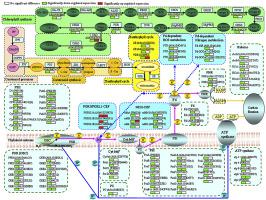Ecotoxicology and Environmental Safety ( IF 6.8 ) Pub Date : 2020-07-03 , DOI: 10.1016/j.ecoenv.2020.110856 Huihui Zhang 1 , Zisong Xu 2 , Kaiwen Guo 2 , Yuze Huo 2 , Guoqiang He 3 , Hongwei Sun 3 , Yupeng Guan 2 , Nan Xu 4 , Wei Yang 2 , Guangyu Sun 5

|
To explore the mechanisms underlying the action of the heavy metals Cd and Zn on the photosynthetic function of plant leaves, the effects of 100 μmol L−1 Cd and 200 μmol L−1 Zn stress (the exposure concentrations of Cd and Zn in the culture medium were 2.24 mg kg−1 and 5.36 mg kg−1) on the chlorophyll and carotenoid contents as well as the photosynthetic function of tobacco leaves (Long Jiang 911) were studied. The key proteins in these physiological processes were quantitatively analyzed using a TMT-based proteomics approach. Cd stress was found to inhibit the expression of key enzymes during chlorophyll synthesis in leaves, resulting in a decrease of the Chl content. However, Zn stress did not significantly influence the chlorophyll content. Leaves adapted to Zn stress by upregulating CAO expression and increase the Chl b content. Although the Car content in leaves did not significantly change under either Cd or Zn stress, the expressions of ZE and VDE during Car metabolism decreased significantly under Cd stress. This was accompanied by damages to the xanthophyll cycle and the NPQ-dependent energy dissipation mechanism. In contrast, under Zn stress, leaves adapted to Zn stress by increasing the expression of VDE, thus improving NPQ. Under Cd stress, the expressions of three sets of proteins were significantly down-regulated, including PSII donor-side proteins (PPD3, PPD6, OEE1, OEE2-1, OEE2-2, OEE2-3, and OEE3-2), receptor-side proteins (D1, D2, CP43, CP47, Cyt b559α, Cyt b559β, PsbL, PsbQ, PsbR, Psb27-H1, and Psb28), and core proteins of the PSI reaction center (psaA, psaB, psaC, psaD, psaE-A, PsaE-B, psaF, psaG, psaH-1, psaK, psaL, psaN, and psaOL). In comparison, only eight of the above proteins (PPD6, OEE3-2, PsbL, PsbQ, Psb27-H1, psaL, and psaOL) were significantly down-regulated by Zn stress. Under Cd stress, both the donor side and the receptor side of PSII were damaged, and PSII and PSI experienced severe photoinhibition. However, Zn stress did not decrease either PSII or PSI activities in tobacco leaves. In addition, the expression of electron transport-related proteins (cytb6/f complex, PC, Fd, and FNR), ATPase subunits, Rubisco subunits, and RCA decreased significantly in leaves under Cd stress. However, no significant changes were observed in any of these proteins under Zn stress. Although Cd stress was found to up-regulate the expressions of PGRL1A and PGRL1B and induce an increase of PGR5/PGRL1-CEF in tobacco leaves, NDH-CEF was significantly inhibited. Under Zn stress, the expressions of ndhH and PGRL1A in leaves were significantly up-regulated, but there were no significant changes in either NDH-CEF or PGR5/PGRL-CEF. Under Cd stress, the expressions of proteins related to Fd-dependent nitrogen metabolism and reactive oxygen species (ROS) scavenging processes (e.g., FTR, Fd-NiR, and Fd-GOGAT) were significantly down-regulated in leaves. However, no significant changes of any of the above proteins were identified under Zn stress. In summary, Cd stress could inhibit the synthesis of chlorophyll in tobacco leaves, significantly down-regulate the expressions of photosynthesis-related proteins or subunits, and suppress both the xanthophyll cycle and NDH-CEF process. The expressions of proteins related to the Fd-dependent nitrogen metabolism and ROS scavenging were also significantly down-regulated, which blocked the photosynthetic electron transport, thus resulting in severe photoinhibition of both PSII and PSI. However, Zn stress had little effect on the photosynthetic function of tobacco leaves.
中文翻译:

生理和蛋白质组学分析表明,重金属镉和锌对烟叶的叶绿素,类胡萝卜素代谢和光合功能有毒作用。
为了探索重金属Cd和Zn作用于植物叶片光合功能的潜在机制,研究100μmolL -1 Cd和200μmolL -1 Zn胁迫的影响(培养物中Cd和Zn的暴露浓度)培养基分别为2.24 mg kg -1和5.36 mg kg -1)研究了龙江911(Long Jiang 911)叶绿素和类胡萝卜素的含量以及光合功能。使用基于TMT的蛋白质组学方法对这些生理过程中的关键蛋白质进行了定量分析。发现镉胁迫抑制了叶片叶绿素合成过程中关键酶的表达,导致Chl含量降低。但是,锌胁迫并未显着影响叶绿素含量。叶通过上调CAO表达适于锌应力并增加叶绿素b内容。尽管在镉或锌胁迫下叶片中的碳含量均无显着变化,但在镉胁迫下,汽车代谢过程中ZE和VDE的表达明显降低。这伴随着对叶黄素循环和依赖NPQ的能量耗散机制的破坏。相反,在锌胁迫下,叶片通过增加VDE的表达而适应锌胁迫,从而改善了NPQ。在镉胁迫下,三类蛋白质的表达被显着下调,包括PSII供体侧蛋白质(PPD3,PPD6,OEE1,OEE2-1,OEE2-2,OEE2-3和OEE3-2),受体-副蛋白(D1,D2,CP43,CP47,Cytb559α,Cytb559β,PsbL,PsbQ,PsbR,Psb27-H1和Psb28)和PSI反应中心的核心蛋白(psaA,psaB,psaC,psaD,psaE- A,PsaE-B,psaF,psaG,psaH-1,psaK,psaL,psaN和psaOL)。相比之下,上述锌蛋白中只有八种蛋白质(PPD6,OEE3-2,PsbL,PsbQ,Psb27-H1,psaL和psaOL)显着下调。在镉胁迫下,PSII的供体侧和受体侧均受损,PSII和PSI受到严重的光抑制作用。但是,锌胁迫并未降低烟叶中PSII或PSI的活性。此外,在镉胁迫下,叶片中电子运输相关蛋白(cytb6 / f复合物,PC,Fd和FNR),ATPase亚基,Rubisco亚基和RCA的表达显着下降。但是,在锌胁迫下,这些蛋白质均未观察到显着变化。尽管发现镉胁迫可上调PGRL1A和PGRL1B的表达并诱导烟叶中PGR5 / PGRL1-CEF的增加,但NDH-CEF却被显着抑制。在锌胁迫下 叶片中ndhH和PGRL1A的表达明显上调,但NDH-CEF或PGR5 / PGRL-CEF均无明显变化。在镉胁迫下,与Fd依赖的氮代谢和清除活性氧(ROS)过程相关的蛋白质(例如FTR,Fd-NiR和Fd-GOGAT)的表达显着下调。然而,在锌胁迫下,没有发现上述任何蛋白质的显着变化。总之,镉胁迫可以抑制烟叶中叶绿素的合成,显着下调光合作用相关蛋白或亚基的表达,并抑制叶黄素循环和NDH-CEF过程。与Fd依赖的氮代谢和ROS清除相关的蛋白质表达也明显下调,它阻止了光合作用的电子传输,从而导致PSII和PSI都受到严重的光抑制作用。但是,锌胁迫对烟叶光合功能的影响很小。

























 京公网安备 11010802027423号
京公网安备 11010802027423号